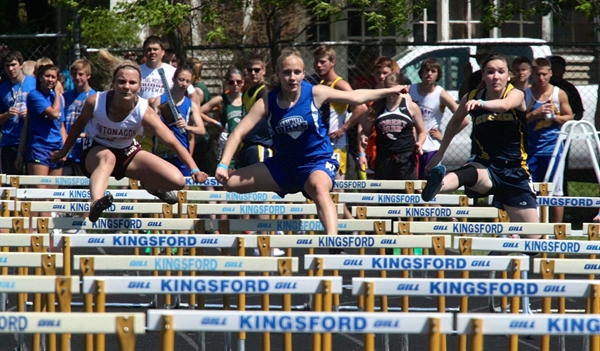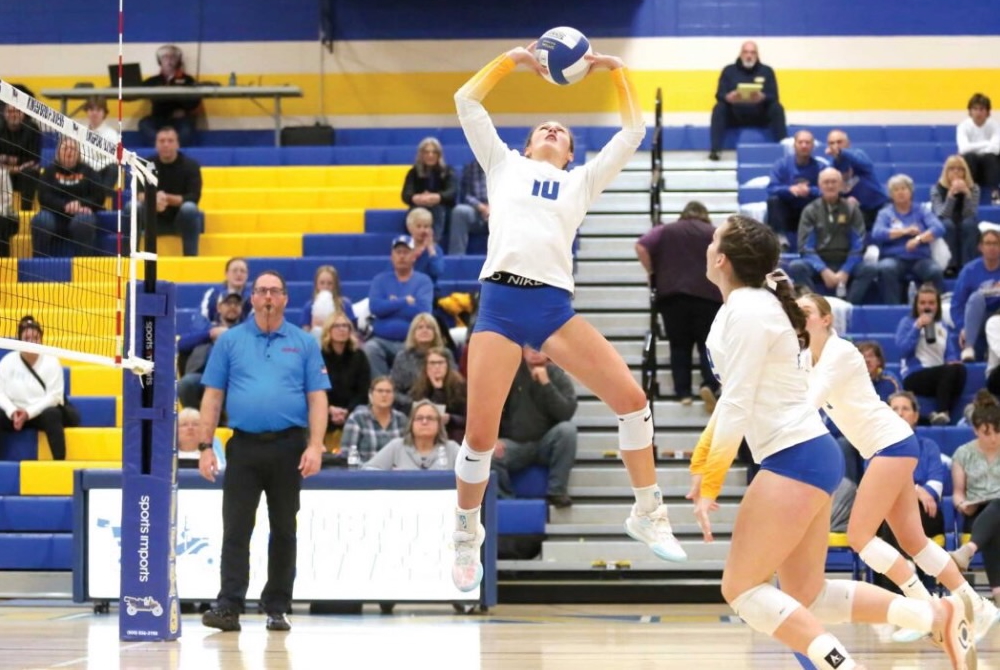
Brimley Girls Add to UP D3 Dynasty
By
John Vrancic
Special for MHSAA.com
June 1, 2014
KINGSFORD — The Brimley girls have earned their share of Upper Peninsula Division 3 track and field championships in recent years.
They added another title to their collection Saturday by scoring 84 points.
The Bays, who won for the fifth time in seven years, were followed by Bessemer with 67 points and Crystal Falls Forest Park with 55.
“When I looked at the times from other Regionals, I realized they ran in snow in some of them,” said Brimley coach Joyel Hyvarinen. “Overall, our girls did a phenomenal job. They had some to prove to everyone and themselves.”
Last year, the Bays were distant runners-up to St. Ignace (121-57).
Brimley’s Kerri Chartrand won the 100-meter hurdles in 16.89 seconds and placed second in the 300 (49.56), anchored the second-place 3,200 relay and took third in long jump at 14 feet, 5¾ inches Saturday.
Anne Archambeau won discus (108-4) and was runner-up in shot put (33-2¾). Her teammates Hana Vesela (32-9½) and Alyssa Hyvarinen (32-6¼) were third and fourth in shot, respectively.
“Our throwers scored 28 points and we had 34 in the field events,” said coach Hyvarinen. “Those were huge for us.”
Kerri Chartrand and Vesela helped the Bays take second in the 1,600 relay, with Vesela also helping the third-place 800 relay. Emily Chartrand added a third in the 3,200 (13:30).
Also helping Brimley’s 1,600 relay were Cassue Leapley and Kaylee Hill.
Bessemer’s Lily Wieringa won the 3,200 in 13:14.61, placed third in the 1,600 (5:54.81) and helped the Speedgirls place third in the 3,200 relay. Breena Bogaczyk added a second in discus (104-11) and fifth in shot (31-11), and Valerie Rowe took third in the 300 hurdles (49.74) and pole vault (8-6).
Senior Mary Granquist led Forest Park, winning the 100 (13.34) and 400 (1:04.72) and anchoring the winning 800 relay and taking second in the 200 (27.63).
Mid Peninsula senior Kelsey Shope retained her high jump title (5-1) and was runner-up in the 400 (1:05.61).
“I was expecting to do a little better in high jump,” said Shope. “My legs and back are real shore, although I’m happy with first. I thought things went real well overall. I think we did real well as a team. This is kind of sad because this is what I’m used to. This has been a great year.”
Munising freshman Michaela Peramaki, who soared a school-record 10 feet in pole vault in a recent meet, settled for a winning jump of 9-0 on Saturday.
Rudyard senior Savannah Dugan had the day’s longest toss in shot put (38-11) and placed third in discus (101-0).
PHOTO: Brimley's Kerri Chartrand (center) works to the front on the way to winning the 100 hurdles at the U.P. Division 3 Final on Saturday at Kingsford. (Click to see more from RunMichigan.com.)

Kingsford's Kreider Prepared for Next Level After Finishing Stellar Flivvers Career
By
John Vrancic
Special for MHSAA.com
June 19, 2025
KINGSFORD — After completing a successful high school volleyball career, Maddy Kreider is ready to take the next step.
 The Kingsford senior is taking her talents to Michigan Tech, where she’s expected to continue primarily as a setter.
The Kingsford senior is taking her talents to Michigan Tech, where she’s expected to continue primarily as a setter.
“That will be a big step for sure, but it’ll be exciting being with the girls,” she said. “The girls are taller in college. It will definitely be an adjustment, physically and mentally. We’ll be traveling longer distances, and it’ll be a matter of improving the mental part of my game.”
Kreider was selected the Upper Peninsula’s Defensive Player of the Year her final two seasons after the U.P. Sportswriters and Sportscasters Association began voting for all-U.P. volleyball.
“That’s quite an accomplishment,” she said. “It’s a real honor playing with girls I grew up with. We had a great season.”
The 5-foot-8 setter was a four-year starter and two-year team captain at Kingsford, leading the Flivvers to three Division 2 District titles and back-to-back undefeated Great Northern Conference championships. She twice was named GNC Player of the Year.
She was also selected all-state first team in the fall and all-state second team in 2023, and all-region throughout her prep career. Her serving percentage also topped .900 throughout her four seasons on varsity.
 Last fall, the Flivvers reached the Regional Semifinal at Manistique where they dropped a 3-2 decision to Kingsley.
Last fall, the Flivvers reached the Regional Semifinal at Manistique where they dropped a 3-2 decision to Kingsley.
“I thought we’d get through,” Kreider said. “We came out lights out in the first two sets, then it was close in the last three.”
Also among the team’s highlights this past fall was a victory at Calumet, approximately 2½ weeks after dropping a 3-1 decision to the Copper Kings on Kingsford’s home floor.
“We wanted to play them,” Kreider said. “They’re a great bunch of girls to play against. They’ve been the measuring stick up here for many years. Winning on their floor was super exciting. We knew we had to play well just to be competitive. That was a great confidence builder for our group. We were definitely on a high going into the District.”
The Flivvers opened their postseason with a 3-1 triumph over Houghton, then defeated Escanaba in straight sets in the District Final.
Kreider will join Calumet senior Maddie Torola at MTU this fall. Torola, who recorded a season-high 19 kills in the four-set victory at Kingsford, helped the Copper Kings finish 29-5 and reach the Division 3 Regional Final at Sault Ste. Marie where they dropped a 3-2 decision to Traverse City St. Francis.
“It was fun playing against her in high school,” Kreider said. “It will be even more fun playing as teammates. It’ll be exciting to be playing on the same team.”
Both will be playing under new head coach Cindy Pindral at Tech. Both of Kreider’s parents played for the Huskies, her mother (and Kingsford varsity coach) Jaclynn volleyball from 1998-2002 and her father Jason basketball from 1997-2000.
Maddy Kreider recently earned an additional honor when she was selected Female Athlete of the Year for Kingsford’s Class of 2025. She recently completed a solid track & field season for the Flivvers.
At the U.P. Division 1 Finals, Kreider placed fourth in the 100-meter dash (13.2) and anchored the Flivvers to a third-place finish in the 800 relay (1:51.57) and fourth in the 400 (53.03) on their home track.
Kreider was named one of 32 MHSAA/Farm Bureau Insurance Scholar-Athlete Award winners this winter and plans to study exercise science and kinesiology at MTU.
 John Vrancic has covered high school sports in the Upper Peninsula since joining the Escanaba Daily Press staff in 1985. He is known most prominently across the peninsula for his extensive coverage of cross country and track & field that frequently appears in newspapers from the Wisconsin border to Lake Huron. He received the James Trethewey Award for Distinguished Service in 2015 from the Upper Peninsula Sportswriters and Sportscasters Association.
John Vrancic has covered high school sports in the Upper Peninsula since joining the Escanaba Daily Press staff in 1985. He is known most prominently across the peninsula for his extensive coverage of cross country and track & field that frequently appears in newspapers from the Wisconsin border to Lake Huron. He received the James Trethewey Award for Distinguished Service in 2015 from the Upper Peninsula Sportswriters and Sportscasters Association.
PHOTOS (Top) Kingsford’s Maddy Kreider sets for her teammates during a match last season. (Middle) Kreider, right, takes a photo with Kingsford’s Male Athlete of the Year Gavin Grondin. (Photos provided by the Kingsford athletic department.)

